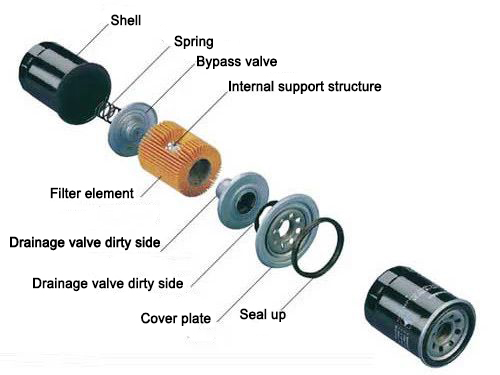The composition and characteristics of the oil filter
1. Filter paper:
Oil filter requires higher filter paper than air filter, mainly because the temperature of the oil varies from 0 to 300 degrees. The filter paper of high quality oil filter should be able to filter impurities under severe temperature changes. Also ensure sufficient flow.
Inferior and low-cost filter paper is made of cotton pulp paper. The filter effect is very poor. It is easier to decompose and dissolve into the oil, block the oil passage, accelerate the deterioration of the oil, and even without the filter element, it will accelerate the engine damage.
2. Rubber seals:
The high quality oil filter seals are made of special rubber to ensure 100% oil leakage.
A good oil filter will not leak oil under normal installation conditions. There are many problems with poor quality and low oil leakage.
3. Reflow suppression valve:
Only available in high quality oil filters. When the engine is turned off, it prevents the oil filter from drying out; when the engine is re-ignited, it immediately generates pressure and supplies oil to the engine. (also known as check valve)
Maintain engine lubrication pressure and reduce wear. Inferior and low oil filters have no check valves to accelerate wear during engine start-up.
4. Overflow valve:
Only available in high quality oil filters. When the external temperature drops to a certain value or when the oil filter exceeds the normal service life, the relief valve will open under special pressure, allowing unfiltered oil to flow directly into the engine, lubricating the friction components – not Filtered impurities can increase engine wear. The relief valve is therefore the key to protecting the engine in an emergency. (also known as bypass valve)
Regularly change the oil filter (you need to change the oil filter every time you change the oil) to avoid engine wear due to the opening of the relief valve. Inferior and low-cost machine filters do not have a relief valve. In special cases, there is no supply of lubricating oil, which will cause the cylinder to be pulled, overhauled, or even scrapped.
About the problem of oil leakage after replacing the oil filter
1. For the spin-on filter (iron shell), the rotating force is too large, exceeding the standard 20-60 Newtons (1 kg = 9.8). The correct installation is to install with a 2 kg hand. Do not install with a wrench. When the force is more than 2.5 kg, the sealing ring is easily deformed, and a protruding point is generated along the circumference. Under the impact of the high-pressure airflow, a gap is generated and leaks.
2. The surface dirt that the old oil filter contacts is not cleaned.
3. When removing the old oil filter, the old seal is stuck to the filter seat due to the excessive rotation force of the previous one, and the new oil filter is installed and leaks.
4. The lubrication system is seriously polluted, heavy grease will block the main oil passage (or the sealant will block the oil passage after overhaul), causing internal pressure and impacting the seal ring to cause oil leakage.
5. For the environmental protection filter (paper filter), the vast majority of the guide rods are not removed inside the seal, and a new seal is installed.
6. When the environmental protection filter (paper filter) is replaced, there is no replacement of the new inner seal.
7. The environmental protection filter (paper filter) is still too large for the outer seal ring (large) to cause severe deformation or concealment, and it is impacted and leaked under pressure during work.
Post time: Sep-16-2019





